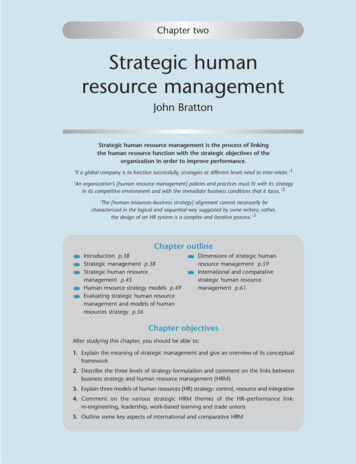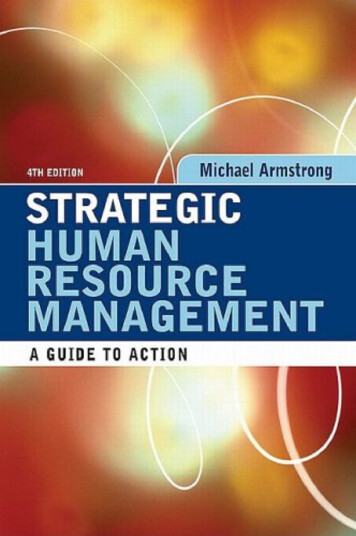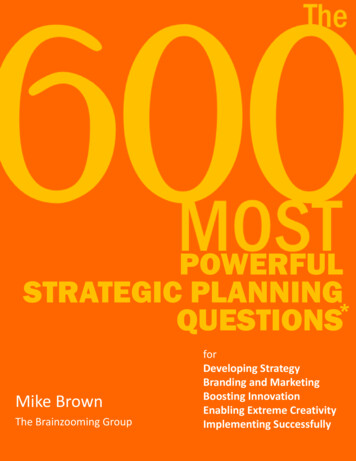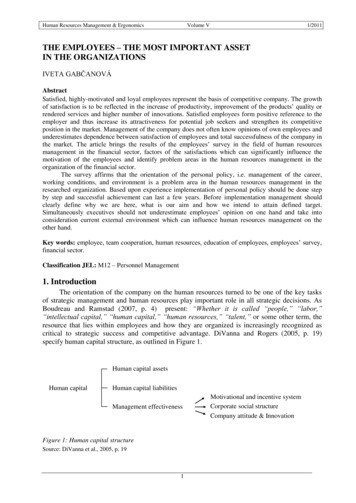
Transcription
International Journal of Business and Social ScienceVol. 3 No. 16 [Special Issue – August 2012]The Role of Strategic Human Resource Management in Creation of CompetitiveAdvantages (Case Study: A Commercial Organization in Malaysia)Dr. Mahnaz Hemmati Noedoust GilaniAssistant ProfessorDepartment of Management (Public Administration)Payame Noor UniversityPO BOX 19395-3697 Tehran, I.R of IranMohammad Sadeghi ZadehMBA (General Management) GraduateGraduate School of ManagementMultimedia UniversityCyberjaya, MalaysiaHamid Reza SaderiMBA (Finance) GraduateGraduate School of ManagementMultimedia UniversityCyberjaya, MalaysiaAbstractThis research is conducted to present ideal HR strategies for a commercial organization in Malaysia. Therecommended strategies were designed to emphasis competitive advantages. Research data were collected bydistributing questionnaires, interviewing with managers and assessment of available reports. To develop the mostsuitable HR strategies, SWOT and PEST analytical methods were used. The research findings demonstrated thatthe organization possess an appropriate condition in the input process of human resources both internally andexternally. The organization’s external factors in output and maintenance process of the human resourcesindicated a poor condition. Hence, aggressive strategies wererecommended to be applied in the input process,while defensive strategies were suggested to serve better in the maintenance and out process. It is concluded thatthe successful accomplishment of recommended strategies would guarantee the synergy, coherence andconvergence in the general HR practices, policies and strategies. Thus, certain HR strategies were approved tohave a key role in creating competitive advantages.Keywords: Strategic Human Resource Management; Competitive Advantages; SWOT Analysis; PEST AnalysisIntroductionThe human resource management system in any organization, given the constantly changing and dynamicenvironment, cannot be a static and fixed phenomenon. Strategic human resource management could serve theorganizations in acquiring the competitive advantages. Under the strategic human resource framework,organizations are able to optimize their utilization of opportunities. Strategic management of the human resourcesbrings the necessary coordination between various activities of an organization; moreover, it helps in creatingappropriate opportunities and preventing the potential threats. Strategic integration is an inevitable necessity increating consistency between human resource strategy and organizational strategy. Therefore, the ultimatepurpose of developing the strategic integration is to generate a harmonic relationship between the goals ofHRMand the organizational objectives (Aarabi and Izadi, 1381). Today, firms believe that the system of internallycoherent HR practices associated with organizational strategies, rather than separate HR plans being practiced inisolation, may boost organizational performance and productivity (Lepak, Liao, Chung, & Harden, 2006).225
The Special Issue on Contemporary Research in Arts and Social Science Centre for Promoting Ideas, USAThe present research consists of the detailed study of the input, maintenance and output processes of the humanresources. This research have employed the Delphi method, SWOT and PEST analysis in order to identifytheorganization’s internal factors (strength and weakness), external factors (opportunities and threats) and todetermine the optimal human resource strategies. Thereafter, based on the concentration of the average points,standard deviation of internal and external (IE) factors matrix and the outcomes from the meetings with themanagement and experts of the organization, optimal strategies of human resources are selected, prioritized andproposed to the organization from the available developed strategies.Literature ReviewIn recent decades, theories and literature regarding the strategic human resource management (SHRM) have beengiven a due importance by the researchers (Delery, 1998; Snell, Youndt& Wright, 1996; Ulrich, 1997a). Strongand comprehensive theoretical frameworks help in concentration and consolidation of the research efforts thusfacilitates the HRM practices to convert into real strategic standards (Ulrich, 1997b).SHRM is based on two principles. First is the belief regarding the vital strategic importance of the organization’shuman resources. This explains the idea that every employee’s personal traits, talent, behavior and interactionpossess an inner potential in formulating basic strategies and more importantly, putting strategies into practice.Second is the thought that in order to bring up strategic strength in the organization, the HRM practices arecertainly utilizable (Colbert, 2004).Appropriate methods of HRM can have an important role in the strategic success of organizations.Wright andMcMahan (1992) defined strategic human resource management (SHRM) as ‘the pattern of planned humanresource deployments and activities intended to enable the firm to achieve its goals’ (p. 298).In 1980, a strategicapproach to human resources was emphasized by many scholars. Changes in thinking and practice caused anincrease in specialization and thus it led to less use of the term "personnel management" in Human ResourceManagement (Miller, 2006).In the 1980s and 1990s, changes in the operational environment of HRM, drew theattention to the strategic management of the human resources.According to studies done by many researchers, for instance, Hendry and Pttigrew (1990) and Mabey et al.(1998), one of the most important issues in the 1980s which developed the SHRM, was the industrial crisis in theUnited States of America. This led to major changes in personnel management and the attention to the strategicmanagement of human resources was increased (Millmore et al., 2007).In recent years, SHRM has been very useful in developed countries. According to the researches, more than halfof organizations in these countries by using the results of the predefinedHR strategiescould achieve newcapabilities in their strategic HRM.Fambrun and his colleagues believed that the human resource systems andorganizational structures must be managed in such a way that they are consistent and compatible with theorganizational strategies. Miller argues that HR strategies should be integrated with corporate strategies. For thisintegration, the management measures in the field of human resources should be coordinated and synchronizedwith other areas of the organization's activities (Armstrong and Baron, 2005).A number of researchers studying the interaction of organization’s systems and human resource management havefound that SHRM by creating harmony between organizational strategies andHRpolicies bring synergy to theactivities of an organization (Chadwick, 2005).Many HR researchers believe that, the HR department should havea greater role in strategy formulation and organization of forces. HR systems should strive to be harmonious withthe overall strategies of the organization (Tyson, 1987).In developing countries, applying the models of HR strategy is not given a due consideration. Few studies havefocused and examined the importance of the strategic HRM and its impact on the overall organizational success inMalaysia. The main reasons are the newly emerged SHRM relevant knowledge, lack of maturation of strategicdialogue in this area, lack of resources and references in native languages, lack of attention to the localization ofsuccessful and innovative international models.The matrix of SWOT analysis is an important tool through which managers can compare the information andprovide four types of strategies. Comparison of the internal and external key elements of this matrix is the mostimportant part, as it requires a precise judgment.226
International Journal of Business and Social ScienceVol. 3 No. 16 [Special Issue – August 2012]Table 1: SWOT MatrixInternal FactorsStrengthsWeaknessesOpportunitiesSO StrategiesWO StrategiesThreatsST StrategiesWT StrategiesExternal Factors SO Strategies: It is determined by using the internal strengths and external opportunities.WO Strategies: By using external opportunities, internal weaknesses can be reduced or eliminated.ST Strategies: By using the internal strength, external threats can be reduced or eliminated.WT Strategies: Internal weaknesses are reduced and external threats can be avoided.In order to design a SWOT Matrix, the following eight steps are to be completed:1)2)3)4)5)6)7)8)Prepare a list of major opportunities of the organization’s external environment.Prepare a list of major threats of the organization’s external environment.Prepare a list of major strength of the organization’s internal environment.Prepare a list of major weaknesses of the organization’s internal environment.Compare internal strengths with external opportunities and enter the result under the SO strategies.Compare internal weaknesses with external opportunities and enter the results under the WO strategies.Compare the internal strength with external threats and enter the results under ST strategies.Reducing internal weaknesses and avoiding external threatsThe purpose of the PEST analysis is to study the environmental factors including political, economic, social andtechnological. This evaluation helps in identifying the factors of SWOT analysis, thus it leads to a transparentunderstanding of the environmental condition of the organization (Manktelow, 2005).Internal and external (IE) matrix is used in order to determine the optimal strategies. In this matrix, the InternalFactors Evaluation (IFE) is displayed on the horizontal axis and External Factors Evaluation (EFE) is on verticalaxis.If the total final score of external factors (EFE) is between 1to 2.5,it represents the external threat and if it’sbetween 2.5 to 4, it indicates the opportunity. Furthermore, if the total final score of internal factors (IFE) isbetween 1to 2.5, it shows the internal weakness and if it is between 2.5 to 4, it suggests the internal strength.227
The Special Issue on Contemporary Research in Arts and Social Science Centre for Promoting Ideas, USAFigure 1: Internal & External Factors (IE)Internal Factors Evaluation (IFE)The position of the organization in every zone of the IE matrix displayed in the above figure, has its own specificstrategic concept. Any organization in zone 1 is situated in an excellent position and it should rather consider theaggressive strategies. Any organization situated in zone 2, possess a perfect external environment, however itsinternal environment is not a good condition. Therefore, the choice of conservative strategy is more appropriatefor this organization. Presence of an organization in zone 3 indicates the great condition of internal environmentwhereas the external environment is in a poor situation. Thus, the competitive strategy is proposed for this type oforganization.An organization that placed in the zone 4 is in a poor condition both in internal and externalenvironment; i.e. it has weakness in the internal environment and is also threatened from the externalenvironment. That being the case, such organizations are advised to resort to the defensive strategies. Afterreviewing the studies and researches, a ten-step process for strategy formulation was proposed to the organization.First step: Evaluation and prospect identification.Second step: Review and recognition of the organization’s vision and mission.Third step:Review and identification of the existing conditions and HRM orientationFourth step: Evaluation and preparing a list of internal factors (weakness and strength) and external factors(opportunities and threats) in the field of human resources management by using Delphi method and presence ofmanagers and selected experts.Fifth step: Preparation and arrangement of questionnaires related to internal and external factors of the humanresources.Sixth step: Examining the questionnaires according to the selected experts and senior manager’s viewpoint.Seventh step: Questionnaires distribution, data collection and analysis.Eighth step: Defining the strategies regarding input, maintenance and output process of the human resourcesNinth step:Receiving opinions from the organization’s managers and experts and applying the necessaryadjustments.Tenth step:Formulating, resolving and dictating the final human resource strategies.Research MethodologyThis study is an applied research, with descriptive and analytical nature which can be considered as a fieldresearch.228
International Journal of Business and Social ScienceVol. 3 No. 16 [Special Issue – August 2012]By making use of the SWOT and PEST analysis besides Delphi method, based on the ten-step research process,internal and external factors were identified and listed.Then the matrix of internal and external factors i.e. EFE and IFE were arranged. Thereafter by using and adjustingthe internal and external (IE) matrix the strategies for input, maintenance and output of the human resources areselected and proposed.Research data are compiled using questionnaires, interviews, meetings with managers and experts as well asanalytical review of the existing reports of the organization. The collected data are analyzed and examined usingSPSS software together with mean statistical methods and standard deviation.Validity and reliability of questionnaireThe main data collection method used in this research is questionnaire. Internal and external factors of humanresources are identified with the help of managers and experts of the organization using Delphi method.Afterwards, the initial questionnaires were designed and prepared. Credibility and validity of the questionnaires isapproved by the academic professionals and executives. In order to assess the reliability of the questionnaire, theCronbach's alpha coefficient is used. The calculated coefficient is 0.83, which indicates the reliability of themeasurement tool.Sample size and sampling methodThe research population includes 910 managers and full-time experts in which a systematic and random stratifiedsampling method is applied to obtain proper samples.By using the statistical software PASS 2004 with 95%confidence, 137 individuals are selected as sample among the managers and experts of the organization.Research FindingsA) Strategies of the human resource input processAfter conducting numerous meetings with managers and expert using Delphi method, the questionnaire wasdeveloped to analyze the internal and external factors.Then, as the data obtained from the questionnaires, thematrix of internal and external factors (SWOT) was designed and the strategies concerning with the input processof the human resources were developed. Finally, using the matrix of internal and external factors (IE), the optimalstrategies among the proposed strategies are chosen and presented.If the total final score of external factors is between1 to 2.5, it is an indication of threat. However, if the score isbetween 2.5 to 4, it hints the existence of opportunity. Therefore, the score of 2.80 in table (2) suggests theexistence of relative opportunity in input process of the organization’s human resource management.229
The Special Issue on Contemporary Research in Arts and Social Science Centre for Promoting Ideas, USATable 2: The External Factors of theHuman Resource Input T8T9Increasing demands for voluntary activities in the organizationHigh inclination among people for being employed in the organizationA positive perspective of the society toward employment in the organizationNational 20-year Development PlanExistence of tendency towards morality in the societyThe availability of fresh graduates in the labor market and opportunity to recruitthem in the organizationPositive perspective towards economic capacity and competency of theorganizationThe existence of proper electronic communications to introduce the organizationin the labor marketThe conformation of the country’s youth populationThe chance of recruiting proficient and expert managers who are interested towork for the organizationThe high rate of unemployment in society and the desire to be employed by theorganizationThe unbalanced academic qualifications of graduates and its effects onrecruiting work forcesThe lack of sufficient experience in university graduatesTraditional managers confrontation with utilizing modern technologies andsolutionsThe lack of HR planning and internal regulationsThe systematic organization of salary and wages of government employeesThe existence of rules and regulations in government recruitment systemTendency of HR specialist to work in industrial and academic sectionsInfluence of political adhesion in promotion and incentiveExistence of various political tendencies and desirability of conformingworkforces with similar political 2.2980.0880.1310.1040.1050.1110.0472.2450.105Σ 12.80Table 3: The Internal Factors of the Human Resource Input W8Reputation, credibility and seniority of the organizationThe adequate capacity for employing human resourceThe existence of responsible and committed manpower in organizationThe feasibility of recruiting HR for professional occupationsThe chance of recruiting graduates from various specialtiesAvailability of applied and training courses during the employmentThe establishment of appropriate system for utilizing the workforceThe effectiveness of organization in the national economyRecruitment of expert administrators from outside of the organizationThe possibility of hiring based on individual’s performance and insider’srecommendationImplementing research for developing HR hiring processThe lack of expert, efficient and eligible human resourceLong recruitment process compared to other organizationsInadequate specialized training in staff induction processDisregarding the improvement of educational & training activitiesThe lack of substitutional managers in operational groupsRefusing to utilize modern and scientific tools in HR input processThe lack of appropriate mechanisms for employing qualified workforceImplication of unnecessary changes due to the lack of appropriate 0.0440.0440.0440.0570.0530.0580.0540.047Σ 50.0850.0820.0780.1000.0910.0990.0900.0772.62If the total final score of internal factors is between1 to 2.5, it points out the weakness; whereas any score between2.5 to 4 signifies the strength. Thus, the score of 2.62 in table (3) is a sign of relative strength in input process ofthe organization’s human resource management.230
International Journal of Business and Social ScienceVol. 3 No. 16 [Special Issue – August 2012]Figure 2: IE Factors for the Input Process of the Human ResourceInternal Factors Evaluation (IFE)As it is illustrated in figure 2, the average points and the standard deviation of the internal and external factors aremostly concentrated in zone one; and their dispersion could be found in zone 2 and 3. Therefore, among thedesigned strategies, all the aggressive strategies along with some conservative and competitive strategies areselected as the optimal and most appropriate strategies for the input process of the human resources. Table (4)presents the suggested strategies in order of priority.Table 4: Suggested Strategies for the Input Process of the Human T1ST2ST3SO StrategiesThe use of organization’s reputation and HR system to attract & hire volunteersIncreasing the capacity and recruitment opportunities for professional &expertise positionsOptimum utilization of facilities to hire the educated and selective candidatesEstablishment of an appropriate information and communication platform, inorder to introduce the organization & to attract the qualified manpower.Introducing professional and expert positions to candidatesDesigning a consistency between training during induction process and job’smissions and responsibilitiesPreparing organization forimplyingsubstantialtraining procedures during thestaff induction processUtilizing facilities especially HR tools to imply appropriate system ofrecruitment processEmploying internal workforces to find qualified and eligible new employeesHighlighting the organization’s role in the national economy in order to attractmore experienced and professional managersExerting fundamental, scientific and modern methods in recruitment processWO StrategiesCreation of a mechanisms for implying more effective induction programsFormulation and establishment of specific policies to prevent unnecessaryrotations in tasksST StrategiesUsing necessary professional training torevise negative perceptions amongtraditional managersRestituting the negative effects of government restrictions on wages and salariesProvide an opportunity to make modern technologies known to 3S4,5,6T5,6S4,7T4,3S6,9231
The Special Issue on Contemporary Research in Arts and Social Science Centre for Promoting Ideas, USAThe results derived from tables (2), (3) and figure (2) proves that the organization in its human resource inputprocess, from the internal and external aspect, is in a favorable condition and above the average; because the totalfinal score of external factors is 2.80 and that of internal factors is 2.62 which are both greater than 2.5.B) Strategies of the human resource maintenance processAfter conducting several meetings with the managers and experts in the organization using Delphi method, andpreparing a questionnaire regarding the opportunities, threats, strengths and weaknesses of the organization, theassessment matrix of internal and external factors is developed. Next, the strategies of the human resourcemaintenance process are designed by using the SWOT analysis matrix. Finally, by utilizing the IE matrix, themost appropriate strategies are selected from the offered strategies.Table 5: The External Factors of the Human Resource Maintaining 9T10The positive effects of organizational ethics and culture on employee’s behaviorThe existence of HR training and development centers, including highereducation institutionsThe country’s 20-year general outlookConsidering the use of modern technologies by the organization to boostproductivityCountry development programsPossible utilization of external financial resources to provide skillful manpowerGovernment’s positive perspective towards human resource developmentprogramsConsidering a system based on meritocracyEfficient reaction of the organization to the housing crisisLower job security in private sector of the economyA lower range of wages for professional jobs in the organizationInappropriate advertising by the media about organization’s activitiesInconsistency between employee’s salaries & incentives and their relativeactivitiesShortage in the organization’s facilities and its day-to-day needsThe absence of meritocracyThe lack of rules and regulations for paying incentives related to productivity ofemployeesThe fluctuating trends in national economyInstability in rules, regulations and instructionsContinuous reduction of employee’s purchasing powerPersistent changes of the HR rules and regulations by the 480.049Σ 11.6491.6481.5302.2330.0660.0800.0730.1102.37The total final score of external factors between1 to 2.5 indicates threat and any score between 2.5 to 4 showsopportunity. Therefore, the score of 2.40 in table (5) suggests the presence of threat in the maintenance process ofhuman resources in the organization.If the total final score of internal factors is between1 to 2.5, it shows the weakness and if the score is between 2.5to 4, it signifies the strength. Thus, the score of 2.12 in table (6) demonstrate a relative weakness in themaintenance process of human resources in the organization.232
International Journal of Business and Social ScienceVol. 3 No. 16 [Special Issue – August 2012]Table 6: The Internal Factors of the Human Resource Maintaining W8W9W10W11W12W13W14W15W16W17W18W19W20Establishment of in-service training centersEngaging professional instructors to train personnelBackground, volume and variety of training programs in the organizationStriving to use modern educational & training technologiesManagement’s positive perspective toward staffs trainingExistence of job security for permanent employeesTeam working spirit among the personnelProviding social & welfare services to personnelExistence of formal and/or friendly relationship among employees and managersVariation in the compensation mechanismConducting a system to consider employee’s complaintsExempting certain rules and regulations in allocating amenitiesIncompatibility between age, position and seniorityThe lack of promotional system based on productivityDisregarding necessities in exerting training programsIncompatibility between positions and their holdersThe lack of a comprehensive HR evaluation systemInsufficient number of professional advisors in personnel managementImplying unnecessary changes due to the lack of appropriate planningThe lack of fair and reasonable paying system consistent with personnel expertiseThe lack of working experience or academic backgroundThe shortage of professionals in analyzing job & vacanciesAmbiguity in the structures of organizational cultureInadequate faith and belief about organizational changes among the middle andbasic managersLower wages and salaries compared to other organizationsConsiderable distance between top, middle, operational managers and employeesAppointing staffs without having relative necessary applied educationLack of education and training of managers and employeesLack of systematic performance-based reward systemLack of manpower planning systems such as career planning and succession.The lack of criteria for relocating executives & 0.0410.0290.0420.0280.0260.0310.0330.029Σ 50.0400.0450.0490.0392.11233
The Special Issue on Contemporary Research in Arts and Social Science Centre for Promoting Ideas, USAFigure 3: IE Factors for the Human Resource Maintaining ProcessInternal Factors Evaluation (IFE)As illustrated in figure (3), the focus of the average points and standard deviations of the internal and externalfactors are in zone 4 and their dispersion is felt in zone 2 and 3. Therefore, from the available strategies, all thedefensive together with some conservative and competitive strategies are picked out as the optimal strategies inmaintaining the human resources. Prioritized lists of these strategies are suggested in table (7).The outcome from table (5), (6) and figure (3) reveals that the human resource maintenance process of theorganization, considering its internal and external factors, is in an unfavorable condition since it is below theaverage. This is because, the total final score of external factors is 2.37 and that of internal factors is 2.11, whichare both smaller than 2.5.234
International Journal of Business and Social ScienceVol. 3 No. 16 [Special Issue – August 2012]Table 7: Suggested Strategies for the Human Resource Maintaining WT3WT4WT5WT6ST StrategiesDesigning and exerting fully circumstantial plans for job analyses, benefitingfrom the experienced lecturersSystematization of payment process with respect to employees productivityDeveloping training programs for employees consistent with needs andunforeseen changesRegularizationand reformulation of the changing of rules, circulars andinstructions with the help of academic expertsDesigning and exerting necessary rules to enhance payments in professional jobsWO StrategiesDesign and reform of educational needs assessment system utilizing moderntechnologyEstablishment of meritocratic procedures in different management levelsArranging the system of reward payments based on performance and productivityEstablishment of a comprehensive HR planning systemIntroduction ofthe personnel consultation system by using the academic expertsEmploying experts to analyze job procedures to perform business analysisDesign and development of administrative reform mechanisms, includingeducation and training.WT StrategiesDevelopment and implementation of specific criteria for equitable distribution offaciliti
The human resource management system in any organization, given the constantly changing and dynamic environment, cannot be a static and fixed phenomenon. Strategic human resource management could serve the organizations in acquiring the competitive advantages. Under










